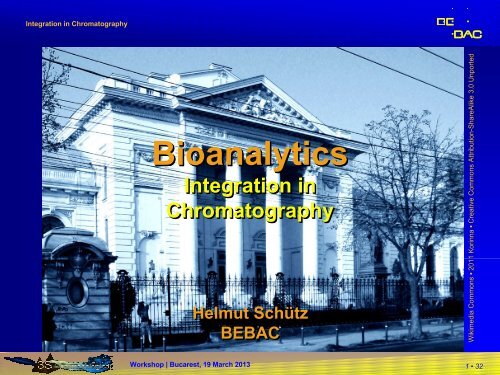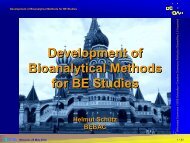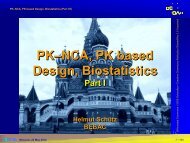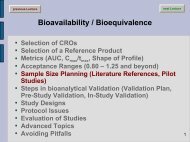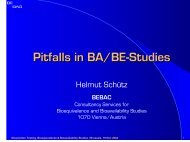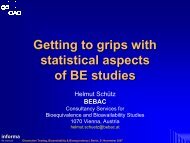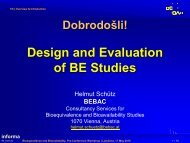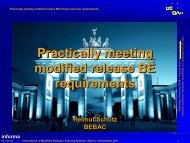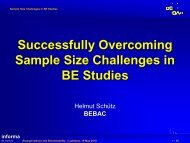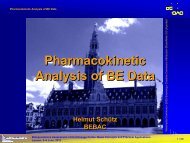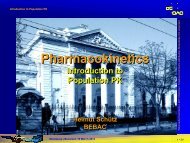Integration in Chromatography - BEBAC ⢠Consultancy Services for ...
Integration in Chromatography - BEBAC ⢠Consultancy Services for ...
Integration in Chromatography - BEBAC ⢠Consultancy Services for ...
Create successful ePaper yourself
Turn your PDF publications into a flip-book with our unique Google optimized e-Paper software.
<strong>Integration</strong> <strong>in</strong> <strong>Chromatography</strong><strong>Chromatography</strong>•Substances (analytes & <strong>in</strong>terferences) cont<strong>in</strong>uouslyexchange between Mobile andStationary Phases•Different Mechanisms <strong>in</strong> parallel (solubility, lipophilicity,ionization,…)•Retention <strong>in</strong>fluenced by type of Stationary Phase,column lenggth, composition of Mobile Phase (typeand % organic modifier, gradient, pH, buffer),temperature, pressure, flow rate,…Workshop | Bucarest, 19 March 20132• 32
<strong>Integration</strong> <strong>in</strong> <strong>Chromatography</strong>Retention Time and Tail<strong>in</strong>g3.94’ / 82164.24’ / 75365.30’ / 60675.90’ / 53026.50’ / 49558.46’ / 36763.96’ / 53464.26’ / 68095.34’ / 39155.94’ / 43906.56’ / 32128.50’ / 2779Workshop | Bucarest, 19 March 20138• 32
<strong>Integration</strong> <strong>in</strong> <strong>Chromatography</strong>Characteristics of PeaksGaussian PeakTangentsPeak Width at Tangentsprojected to Basel<strong>in</strong>e: wInflection Po<strong>in</strong>ts of GP:Width = 2σat 60.65% of Peak HeightPeak Width at 50%of Peak Height: w 0.5Peak Width at 10%of Peak Height: w 0.1Workshop | Bucarest, 19 March 20139• 32
<strong>Integration</strong> <strong>in</strong> <strong>Chromatography</strong>Characteristics of PeaksGaussian PeakInflection Po<strong>in</strong>t1 st DerivativePeak Time of GP atRoot of 1 st Derivative2 nd DerivativeInflection Po<strong>in</strong>ts of GP atMax/M<strong>in</strong> of 1 st DerivativeInflection Po<strong>in</strong>ts of GP atRoots of 2 nd DerivativeWorkshop | Bucarest, 19 March 201310 • 32
<strong>Integration</strong> <strong>in</strong> <strong>Chromatography</strong>Characteristics of PeaksEMG PeaksT f(0.31/0.18=1.722)T f(0.70/0.32=2.188)Retention time t R(6.58’)Retention time t R(8.46’)Capacity factor k’ (t R-t 0)/t 0=3.387Capacity factor k’ (t R-t 0)/t 0=4.640Tail<strong>in</strong>g factor at 50% heightT f=b/a (0.21/0.19=1.105)w 0.5=0.40’w 0.5=0.49’Elution time ofvoid t 0(1.50’)w 0.1=1.05’IUPAC at 10% heightT f=b/a (0.72/0.33=2.182)w 0.1=1.02’w=~1.699×w 0.5=0.68w=0.830 1 2 3 4 5 6 7 8 9Workshop | Bucarest, 19 March 201311 • 32
<strong>Integration</strong> <strong>in</strong> <strong>Chromatography</strong>Characteristics of Peaks1 st Derivative (slope)0 1 2 3 4 5 6 7 8 9 12 nd Derivative0 1 2 3 4 5 6 7 8 9 1Workshop | Bucarest, 19 March 201312 • 32
<strong>Integration</strong> <strong>in</strong> <strong>Chromatography</strong>Recommendations•Capacity factor k’ <strong>for</strong> analytes >2•Example:(6.58–1.50)/1.50=3.39 (8.46–1.50)/1.50=4.64 •Resolution between two adjacent peaks•R s = 2 × (t R2–t R1) / (w 1 + w 2 )Basel<strong>in</strong>e width w not accessible; <strong>for</strong> a Gaussian [sic]peak w ~ 1.699 × w 0.5 holds.•Desirable >2•Example: 2×(8.46–6.58)/(0.68+0.83)=5.69 Workshop | Bucarest, 19 March 201313 • 32
<strong>Integration</strong> <strong>in</strong> <strong>Chromatography</strong>Recommendations•Run times•The longer, the better the separation – but•Peak heights will decrease(band broaden<strong>in</strong>g → worse LLOQ)•Run times are decreased by• Type of stationary phase C18 → C8• ↓ Column length• ↑ Particle size 3 µm → 5 µm• ↑ Flow rate• Type of organic modifier <strong>in</strong> mobile phase CH 3 OH → CH 3 CN• ↑ % of organic modifier <strong>in</strong> MP• ↑ TemperatureWorkshop | Bucarest, 19 March 201315 • 32
<strong>Integration</strong> <strong>in</strong> <strong>Chromatography</strong>Hurry up!k’ 3.39T f2.18R s5.69k’ 4.64T f2.190 1 2 3 4 5 6 7 8 9k’ >2, R s >2, T f
<strong>Integration</strong> <strong>in</strong> <strong>Chromatography</strong><strong>Integration</strong>•Peak ‘recognition’•Automatic vs. manual•<strong>Chromatography</strong> Data System (CDS)Workshop | Bucarest, 19 March 201317 • 32
<strong>Integration</strong> <strong>in</strong> <strong>Chromatography</strong><strong>Integration</strong>•Peak ‘recognition’•Peak start and end triggered by:•Upward-/downward slope detection:For a Gaussian peak upward- / downward thresholdsare the same, but <strong>in</strong> chromatography peaks arealways asymmetrical.Some data systems correct <strong>for</strong> that by us<strong>in</strong>g moreslices if the slope is negative or even change to adifferent fitt<strong>in</strong>g algorithm.Workshop | Bucarest, 19 March 201320 • 32
<strong>Integration</strong> <strong>in</strong> <strong>Chromatography</strong>•Peak ‘recognition’<strong>Integration</strong>Basel<strong>in</strong>eChromatogramSlope ThresholdSlopeFour consecutive values abovethreshold: <strong>in</strong>tegration of peaktriggered at data po<strong>in</strong>t –3.5.50 5.75 6.00 6.25 6.50Workshop | Bucarest, 19 March 201321 • 32
<strong>Integration</strong> <strong>in</strong> <strong>Chromatography</strong><strong>Integration</strong>•Automatic vs. manual•<strong>Integration</strong> parameters are saved <strong>in</strong> the CDS’method and work <strong>in</strong> the background•The automatic <strong>in</strong>tegration may fail:•Ma<strong>in</strong>ly <strong>for</strong> small peaks close to the LLOQ•But also (rarely) <strong>for</strong> high peaks,if a series of positive random noise triggers an ‘end ofpeak’ too early ornegative random noise draws the basel<strong>in</strong>e too late.•There is no ‘correct’ <strong>in</strong>tegration <strong>for</strong> any given peak!Identical raw data most likely will result <strong>in</strong> differentvalues if evaluated by another CDS.Workshop | Bucarest, 19 March 201322 • 32
<strong>Integration</strong> <strong>in</strong> <strong>Chromatography</strong><strong>Integration</strong>•Automatic vs. manual•All chromatograms should be reviewed and the<strong>in</strong>tegration corrected if necessary•The review has to be done be<strong>for</strong>e concentrationsare calculated.Chang<strong>in</strong>g <strong>in</strong>tegration of a peak <strong>in</strong> order to <strong>for</strong>ce acalibrator / QC towards the expected value (e.g.,make a batch valid which would be rejectedotherwise) or a pre-dose concentration
<strong>Integration</strong> <strong>in</strong> <strong>Chromatography</strong><strong>Integration</strong>•Automatic vs. manual•Review and manual correction acceptableaccord<strong>in</strong>g to current GLs (FDA 2001, EMA 2011)•SOP <strong>in</strong> place•Consistently across the study’s chromatograms•Report which chromatograms were re<strong>in</strong>tegrated(why, by whom, when – all the usual dataneeded <strong>for</strong> an audit trail).Workshop | Bucarest, 19 March 201325 • 32
<strong>Integration</strong> <strong>in</strong> <strong>Chromatography</strong><strong>Integration</strong>•Automatic vs. manual•Example: LC/MS-MS, risperidone, prote<strong>in</strong> precipitation,dilution factor 8, API 4000, software Analyst1.4.1; 1 ng/mL and 0.1 ng/mL (at LLOQ)<strong>Integration</strong> methodautomated (smooth<strong>in</strong>g 1, bunch<strong>in</strong>g 2)1 ng/mL 0.1 ng/mLCV (n=10)6.5%15.1%manual correction (one analyst)manual correction (ten analysts)6.3%5.2%(3.8% – 6.8%)11.1%12.8%(6.9% – 16.0%)H Kirchherr, Data Evaluation <strong>in</strong> LC-MSIn: H-J Kuss and S Kromidas (eds.), Quantification <strong>in</strong> LC and GC, Wiley, p243-259 (2009)Workshop | Bucarest, 19 March 201326 • 32
<strong>Integration</strong> <strong>in</strong> <strong>Chromatography</strong>•Automatic vs. manual<strong>Integration</strong>•Some analyst are afraid of gett<strong>in</strong>g problems <strong>in</strong> an<strong>in</strong>spection – believ<strong>in</strong>g automatic <strong>in</strong>tegration is the‘gold standard’ and manual <strong>in</strong>tegration some k<strong>in</strong>d ofdata manipulation.•Example:Fairly recent (06/2010) BE study, active l-enantiomervs. racemate, LC/MS-MS; chromatograms of• high calibration standard• low QC sampleWorkshop | Bucarest, 19 March 201327 • 32
<strong>Integration</strong> <strong>in</strong> <strong>Chromatography</strong><strong>Integration</strong>•Automatic vs. manual•It would be possible to calculate peak areas by deconvolution.Not available <strong>in</strong> current CDS!Only supportedby Merck / Hitachi’smid-90sD-7000 HPLCSystem Manager(HSM v4.1) orexternal software(PeakFITfrom Systat).4.0e+53.5e+53.0e+52.5e+52.0e+51.5e+51.0e+55.0e+4Peak 1 (EMG fitted)Peak 2 (EMG fitted)Chromatogram (measured)Chromatogram (EMG fitted)0.0e+05.5 6 6.5 7 7.5 8 8.5 9 9.5 10 10.5Workshop | Bucarest, 19 March 201329 • 32
<strong>Integration</strong> <strong>in</strong> <strong>Chromatography</strong><strong>Integration</strong>•<strong>Chromatography</strong> Data System (CDS)•Bundled with chromatograph / MS• Xcalibur ® (Thermo Scientific)• Analyst ® (Applied Biosystems/MDS Sciex)• EZChrome Elite (Agilent Technologies)• Empower (Waters)• Chromeleon ® (Dionex)• LabSolutions (Shimadzu)•Commercial, vendor <strong>in</strong>dependent• PowerChrom ® (eDAQ)•Cross-plat<strong>for</strong>m freeware• ezDataPowerChrom ® (chemilab.net)•Deconvolution• PeakFIT ® (Systat)Workshop | Bucarest, 19 March 201330 • 32
<strong>Integration</strong> <strong>in</strong> <strong>Chromatography</strong><strong>Integration</strong>•<strong>Chromatography</strong> Data System (CDS)•Important po<strong>in</strong>ts• Audit Trail?• Data transfer to LIMS?• Data <strong>for</strong>mat: Preferable not only the <strong>in</strong>tegrationparameters, but the raw peak slices are stored.• ANDI/netCDF (AIA) <strong>Chromatography</strong> Data InterchangeFormat (ASTM standard E1947-98)• Last resort: CSV (Character Separated Variables)• FDA 21 CFR Part 11 compliant (rarely; ask!)• If possible data should not be stored only at the <strong>in</strong>strument’sPC, but copied to a central location <strong>for</strong> securedbackup.• Provide the sponsor a DVD with raw data files.Workshop | Bucarest, 19 March 201331 • 32
<strong>Integration</strong> <strong>in</strong> <strong>Chromatography</strong>Thank You!<strong>Integration</strong> <strong>in</strong><strong>Chromatography</strong>Open Questions?Helmut Schütz<strong>BEBAC</strong><strong>Consultancy</strong> <strong>Services</strong> <strong>for</strong>Bioequivalence and Bioavailability Studies1070 Vienna, Austriahelmut.schuetz@bebac.atWorkshop | Bucarest, 19 March 201332 • 32


